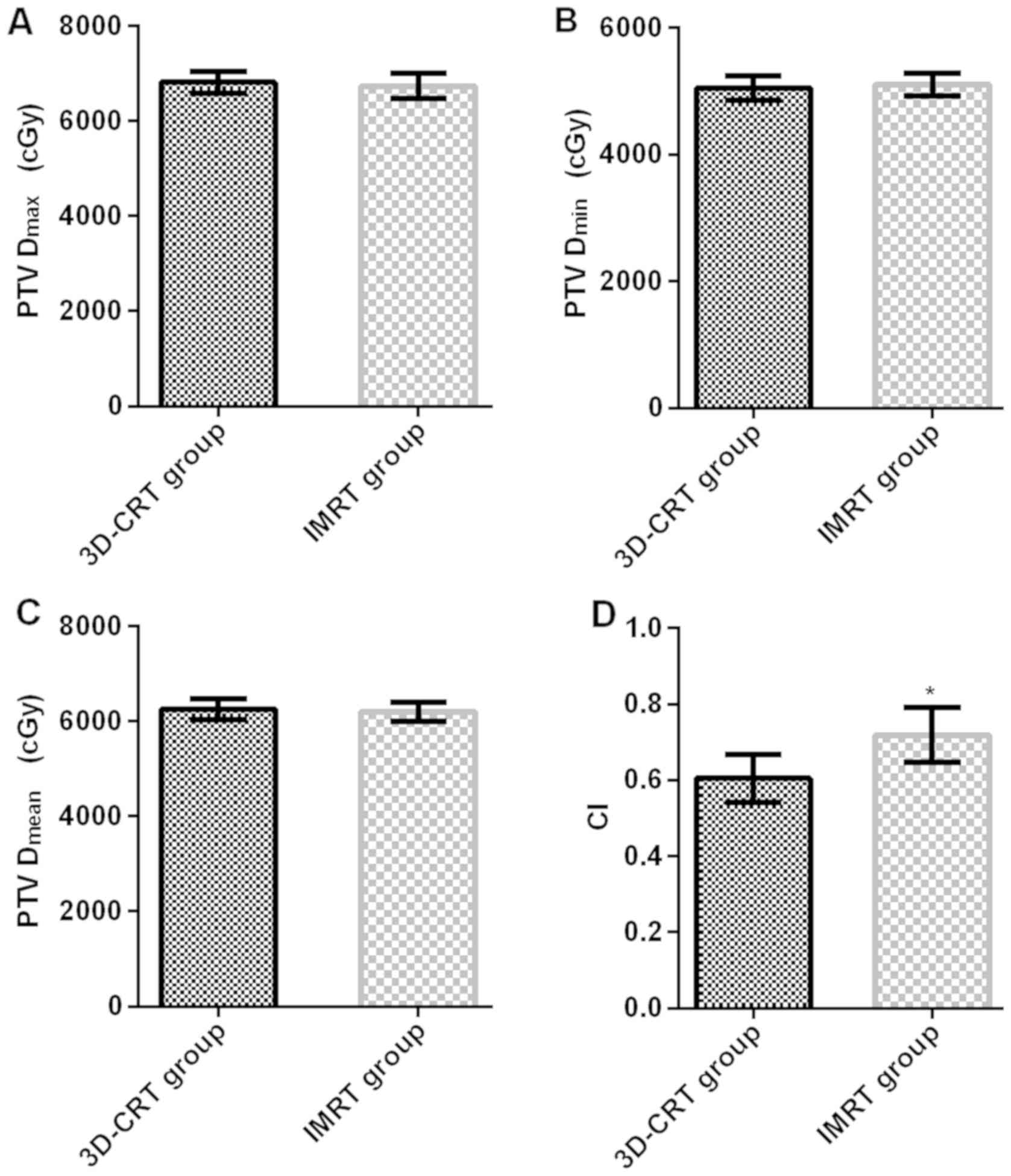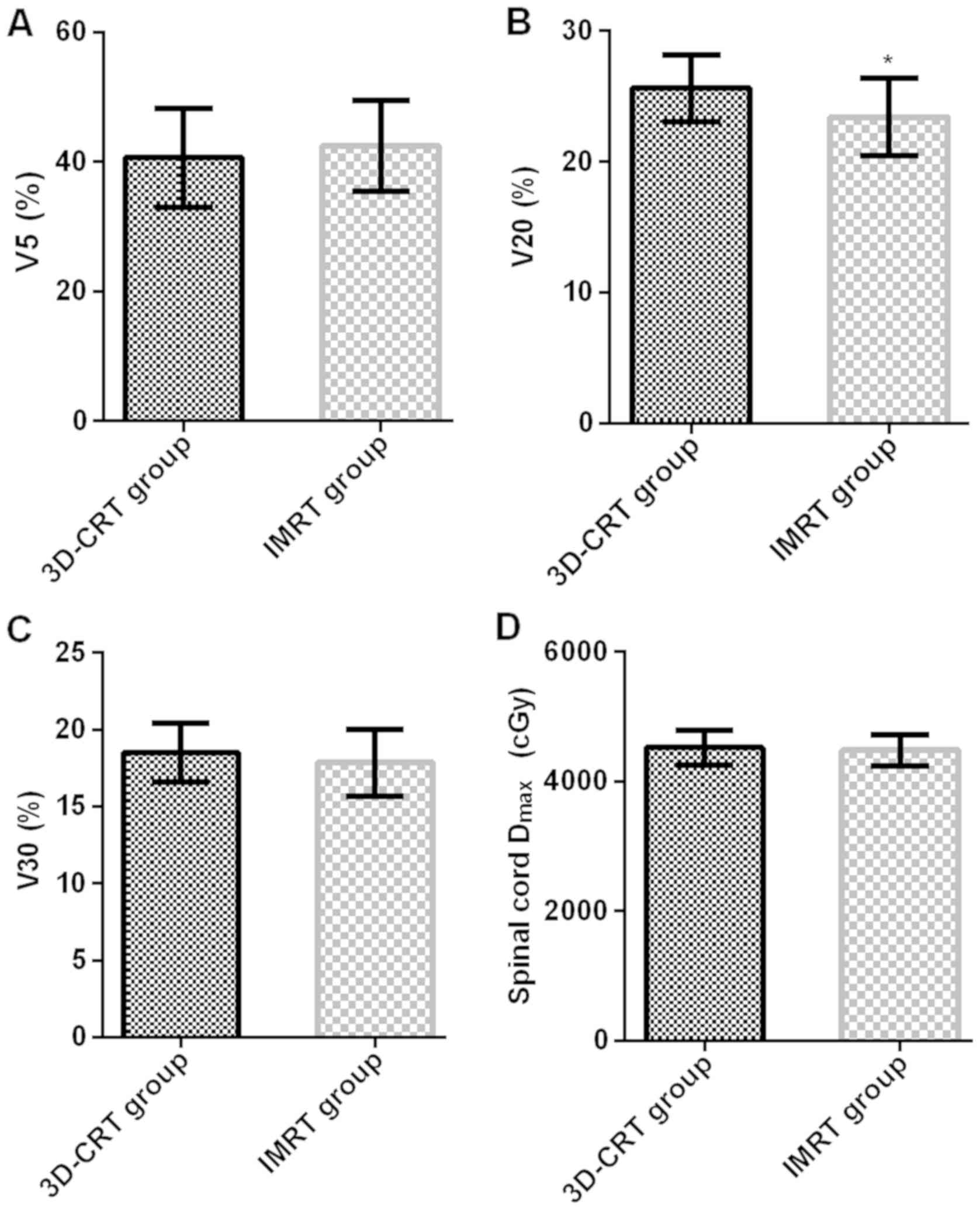|
1
|
Caudell JJ, Carroll WR, Spencer SA and
Bonner JA: Examination of laryngoesophageal dysfunction-free
survival as an endpoint in nonsurgical treatment of squamous cell
carcinomas of the larynx and hypopharynx. Cancer. 117:4447–4451.
2011. View Article : Google Scholar : PubMed/NCBI
|
|
2
|
Pasquali S, Yim G, Vohra RS, Mocellin S,
Nyanhongo D, Marriott P, Geh JI and Griffiths EA: Survival after
neoadjuvant and adjuvant treatments compared to surgery alone for
resectable esophageal carcinoma: A network meta-analysis. Ann Surg.
265:481–491. 2017. View Article : Google Scholar : PubMed/NCBI
|
|
3
|
Chen J, Su T, Lin Y, Wang B, Li J, Pan J
and Chen C: Intensity-modulated radiotherapy combined with
paclitaxel and platinum treatment regimens in locally advanced
esophageal squamous cell carcinoma. Clin Transl Oncol. 20:411–419.
2018. View Article : Google Scholar : PubMed/NCBI
|
|
4
|
Wong AT, Shao M, Rineer J, Lee A, Schwartz
D and Schreiber D: The impact of adjuvant postoperative radiation
therapy and chemotherapy on survival after esophagectomy for
esophageal carcinoma. Ann Surg. 265:1146–1151. 2017. View Article : Google Scholar : PubMed/NCBI
|
|
5
|
McDowell LJ, Huang SH, Xu W, Che J, Wong
RKS, Brierley J, Kim J, Cummings B, Waldron J, Bayley A, et al:
Effect of intensity modulated radiation therapy with concurrent
chemotherapy on survival for patients with cervical esophageal
carcinoma. Int J Radiat Oncol Biol Phys. 98:186–195. 2017.
View Article : Google Scholar : PubMed/NCBI
|
|
6
|
Niezink AGH, de Jong RA, Muijs CT,
Langendijk JA and Widder J: Pulmonary function changes after
radiotherapy for lung or esophageal cancer: A systematic review
focusing on dose-volume parameters. Oncologist. 22:1257–1264. 2017.
View Article : Google Scholar : PubMed/NCBI
|
|
7
|
Suntharalingam M, Winter K, Ilson D,
Dicker AP, Kachnic L, Konski A, Chakravarthy AB, Anker CJ, Thakrar
H, Horiba N, et al: Effect of the addition of cetuximab to
paclitaxel, cisplatin, and radiation therapy for patients with
esophageal cancer: The NRG oncology RTOG 0436 phase 3 randomized
clinical trial. JAMA Oncol. 3:1520–1528. 2017. View Article : Google Scholar : PubMed/NCBI
|
|
8
|
Takeuchi M, Suda K, Hamamoto Y, Kato M,
Mayanagi S, Yoshida K, Fukuda K, Nakamura R, Wada N, Kawakubo H, et
al: Technical feasibility and oncologic safety of diagnostic
endoscopic resection for superficial esophageal cancer.
Gastrointest Endosc. 88:456–465. 2018. View Article : Google Scholar : PubMed/NCBI
|
|
9
|
Japanese Gastric Cancer Association:
Japanese gastric cancer treatment guidelines 2010 (ver.3). Gastric
Cancer. 14:113–123. 2011. View Article : Google Scholar : PubMed/NCBI
|
|
10
|
Xu D, Li G, Li H and Jia F: Comparison of
IMRT versus 3D-CRT in the treatment of esophagus cancer: A
systematic review and meta-analysis. Medicine (Baltimore).
96:e76852017. View Article : Google Scholar : PubMed/NCBI
|
|
11
|
Chen YJ, Liu A, Han C, Tsai PT,
Schultheiss TE, Pezner RD, Vora N, Lim D, Shibata S, Kernstine KH,
et al: Helical tomotherapy for radiotherapy in esophageal cancer: A
preferred plan with better conformal target coverage and more
homogeneous dose distribution. Med Dosim. 32:166–171. 2007.
View Article : Google Scholar : PubMed/NCBI
|
|
12
|
Sun HT, Yang RJ, Jiang P, Jiang WJ, Li JN,
Meng N and Wang JJ: Dosimetric analysis of volumetric modulated arc
therapy and intensity modulated radiotherapy for patients undergone
breast-conserving operation. Beijing Da Xue Xue Bao Yi Xue Ban.
50:188–192. 2018.(In Chinese). PubMed/NCBI
|
|
13
|
Subbiah V, Chuang HH, Gambhire D and
Kairemo K: Defining clinical response criteria and early response
criteria for precision oncology: Current state-of-the-art and
future perspectives. Diagnostics (Basel). 7:102017. View Article : Google Scholar
|
|
14
|
Ali AN, Zhang P, Yung WKA, Chen Y, Movsas
B, Urtasun RC, Jones CU, Choi KN, Michalski JM, Fischbach AJ, et
al: NRG oncology RTOG 9006: A phase III randomized trial of
hyperfractionated radiotherapy (RT) and BCNU versus standard RT and
BCNU for malignant glioma patients. J Neurooncol. 137:39–47. 2018.
View Article : Google Scholar : PubMed/NCBI
|
|
15
|
Abraham JM and Meltzer SJ: Long noncoding
RNAs in the pathogenesis of Barrett's esophagus and esophageal
carcinoma. Gastroenterology. 153:27–34. 2017. View Article : Google Scholar : PubMed/NCBI
|
|
16
|
Muto M, Ohtsu A, Miyata Y, Shioyama Y,
Boku N and Yoshida S: Self-expandable metallic stents for patients
with recurrent esophageal carcinoma after failure of primary
chemoradiotherapy. Jpn J Clin Oncol. 31:270–274. 2001. View Article : Google Scholar : PubMed/NCBI
|
|
17
|
Liu S, Anfossi S, Qiu B, Zheng Y, Cai M,
Fu J, Yang H, Liu Q, Chen Z, Fu J, et al: Prognostic factors for
locoregional recurrence in patients with thoracic esophageal
squamous cell carcinoma treated with radical two-field lymph node
dissection: results from long-term follow-up. Ann Surg Oncol.
24:966–973. 2017. View Article : Google Scholar : PubMed/NCBI
|
|
18
|
Deng JY, Wang C, Shi XH, Jiang GL, Wang Y,
Liu Y and Zhao KL: Reduced toxicity with three-dimensional
conformal radiotherapy or intensity-modulated radiotherapy compared
with conventional two-dimensional radiotherapy for esophageal
squamous cell carcinoma: A secondary analysis of data from four
prospective clinical trials. Dis Esophagus. 29:1121–1127. 2016.
View Article : Google Scholar : PubMed/NCBI
|
|
19
|
Nishiyama K, Kozuka T, Higashihara T,
Miyauchi K and Okagawa K: Acute radiation thyroiditis. Int J Radiat
Oncol Biol Phys. 36:1221–1224. 1996. View Article : Google Scholar : PubMed/NCBI
|
|
20
|
Yang H, Feng C, Cai BN, Yang J, Liu HX and
Ma L: Comparison of three-dimensional conformal radiation therapy,
intensity-modulated radiation therapy, and volumetric-modulated arc
therapy in the treatment of cervical esophageal carcinoma. Dis
Esophagus. 30:1–8. 2017.
|
|
21
|
Grills IS, Yan D, Martinez AA, Vicini FA,
Wong JW and Kestin LL: Potential for reduced toxicity and dose
escalation in the treatment of inoperable non-small-cell lung
cancer: A comparison of intensity-modulated radiation therapy
(IMRT), 3D conformal radiation, and elective nodal irradiation. Int
J Radiat Oncol Biol Phys. 57:875–890. 2003. View Article : Google Scholar : PubMed/NCBI
|
|
22
|
Kong FM, Ten Haken RK, Schipper M, Frey
KA, Hayman J, Gross M, Ramnath N, Hassan KA, Matuszak M, Ritter T,
et al: Effect of midtreatment PET/CT-adapted radiation therapy with
concurrent chemotherapy in patients with locally advanced
non-small-cell lung cancer: A phase 2 clinical trial. JAMA Oncol.
3:1358–1365. 2017. View Article : Google Scholar : PubMed/NCBI
|
|
23
|
Graham MV, Purdy JA, Emami B, Harms W,
Bosch W, Lockett MA and Perez CA: Clinical dose-volume histogram
analysis for pneumonitis after 3D treatment for non-small cell lung
cancer (NSCLC). Int J Radiat Oncol Biol Phys. 45:323–329. 1999.
View Article : Google Scholar : PubMed/NCBI
|
|
24
|
Yom SS, Liao Z, Liu HH, Tucker SL, Hu CS,
Wei X, Wang X, Wang S, Mohan R, Cox JD, et al: Initial evaluation
of treatment-related pneumonitis in advanced-stage non-small-cell
lung cancer patients treated with concurrent chemotherapy and
intensity-modulated radiotherapy. Int J Radiat Oncol Biol Phys.
68:94–102. 2007. View Article : Google Scholar : PubMed/NCBI
|
|
25
|
De Felice F, de Vincentiis M, Luzzi V,
Magliulo G, Tombolini M, Ruoppolo G and Polimeni A: Late
radiation-associated dysphagia in head and neck cancer patients:
Evidence, research and management. Oral Oncol. 77:125–130. 2018.
View Article : Google Scholar : PubMed/NCBI
|












